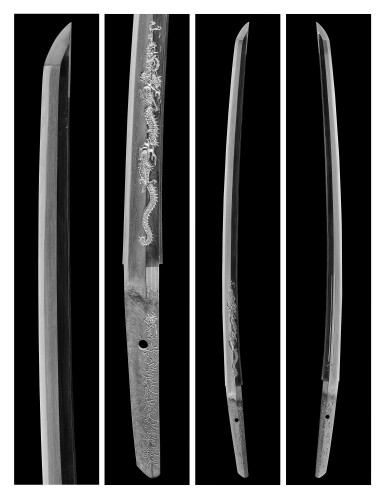The Samurai: Japanese Arms and Armour
The Samurai: Japanese Arms and Armour

Property from an Important Private Collection
A wakizashi | Signed Banshu Tegarayama no fumoto Fujiwara Ujishige seitan saku (carefully forged by Fujiwara Ujishige at the foot of Mount Tegaraya in Harima Province) | The ura signed Otoko Masatoshi kore o horu (carved by Otoko Masatoshi) | Edo period, 18th century
Lot Closed
May 16, 12:46 PM GMT
Estimate
15,000 - 20,000 GBP
Lot Details
Description
Property from an Important Private Collection
A wakizashi
Signed Banshu Tegarayama no fumoto Fujiwara Ujishige seitan saku (carefully forged by Fujiwara Ujishige at the foot of Mount Tegaraya in Harima Province)
The ura signed Otoko Masatoshi kore o horu (carved by Otoko Masatoshi)
Edo period, 18th century
Sugata [configuration]: Shinogi-zukuri, deep tori-zori, o-kissaki
Kitae [forging pattern]: Ko-itame hada, with jinie
Hamon [tempering pattern]: Suguha in niedeki, deep nioikuchi
Boshi [tip]: Rounded maru-boshi with deep nioikuchi
Horimono [carvings]: The omote finely carved, chased and engraved with an ascending three-clawed dragon, the ura with futasuji-hi [double grooves] above stylised rendai [lotus blossom throne]
Nakago [tang]: One mekugi-ana, the omote signed Banshu Tegarayama fumoto Fujiwara Ujishige seitan saku (carefully forged by Fujiwara Ujishige at the foot of Mount Tegaraya in Banshu [Harima] Province), the ura signed Otoko Masatoshi kore o horu (carved by Otoko Masatoshi).
Habaki [collar]: Gold, single clad
In shirasaya [plain wood scabbard]
Nagasa [length from kissaki to machi]: 56 cm., 22 in.
Sori [curvature]: 1.1 cm., ½ in.
Saki-haba [width at the yokote]: 1.9 cm., ¾ in.
Moto-haba [width at the machi]: 2.5 cm., 1 in.
Accompanied by a certificate of registration as Hozon Token [Sword Worthy of Preservation], no. 3013824 issued by the Nihon Bijutsu Token Hozon Kyokai [Society for the Preservation of the Japanese Art Sword], dated Heisei 28 (2016).
The second generation Ujishige, son of the first generation, is recorded as using this signature during the Meiwa period (1764-1772).
There is a katana with an almost identical inscription (lacking fumoto) in the Tokyo Fuji Art Museum.
